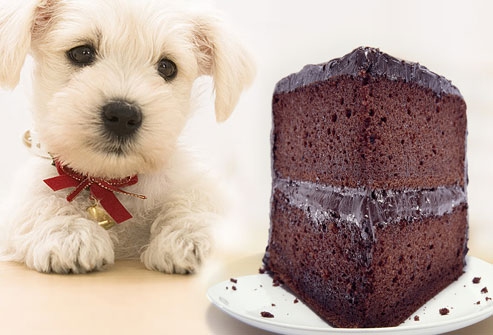Do you own a dog? Do you often share your snacks with them? When it comes to sharing meals with your canine companion, there is one particular treat you shouldn’t feed your dog -chocolate. While it is a healthy snack for humans, chocolate is toxic to dogs. It can lead to serious illness or even death. Vets rate chocolate consumption as one of the most common causes of dog poisoning. Therefore, as a dog owner, it is important for you to learn why chocolate is harmful and what to do in case your dog eats chocolate.

Dogs and Chocolate – Why Chocolate Is Toxic to Dogs?
Chocolate is made with caffeine and theobromine. These are two components known to stimulate the dog’s nervous system and cause an increase in heart rate. While the human body can easily digest theobromine, dogs process this component slower. This gives it time to build up in the system to a point where it becomes toxic. The amount and type of chocolate ingested will determine the risk of the dog becoming ill. The weight of the dog is also a factor to consider. The concentration of toxic substances found in chocolate is different in various types of chocolate.
Below is the list of chocolate types in order from the most toxic:
Cocoa powder – this is the most toxic type. Contains up to 800mg of theobromine in 25 grams of cocoa
Unsweetened chocolate for bakers – contains about 450 mg of theobromine
Semi-sweet chocolate – contains about 150 mg of theobromine
Dark choc – contains about 160 mg of theobromine
Milk choc – contains between 44 to 64 mg of theobromine
White choc – contains very little theobromine
Cocoa, dark chocolate and cooking chocolates have the highest amounts of theobromine and are the most dangerous to dogs. You need less than an ounce of dark chocolate to poison a dog that weighs 44 pounds. The size of the dog matters because a large dog is able to consume more chocolate than a small dog before it experiences the effects.
Small chocolate quantities will probably only bring about stomach upsets to the dog. Other side effects can be diarrhea and vomiting. When dogs take in large quantities of chocolate, it can lead to seizures, muscle tremors, heart attack, internal bleeding and irregular heart pulses. The first sign of chocolate poisoning is extreme hyperactivity.
What to Do if Your Dog Ingests Chocolate
Dogs and chocolate are a bad combination. If you suspect that your dog has eaten chocolate, it is advisable to seek a vet’s help immediately. Do not sit and wait for symptoms to show. Sometimes, it may take up to 12 hours before the symptoms are experienced.
Once your dog has eaten chocolate, the first symptom is vomiting. If your dog does not vomit, it is advisable to give it hydrogen peroxide as this helps induce throwing up. You should give him a tablet for every 20 pounds. Medicine droppers or a turkey baster can be used to administer the peroxide.
If this proves hard to do, you can use peanut butter in the feeding bowl and place the peroxide on the rim of the bowl. The dog will eat the butter and lick the peroxide. Once the dog vomits, do not feed it anything.
The theobromine in chocolate can stay in the dog’s system for a long time. The symptoms can be experienced for up to 72 hours. When you seek medical help quickly, you lower the risk of death and it is cheaper. A vet is in the right position to assess the severity of the problem and treat the dog accordingly.
Vets mostly use IV drugs and fluids to treat chocolate poisoning in dogs. Apomorphine will be used to cause vomiting. Stomach pumping will also be done to flush out any traces of the chocolate that is yet to be digested. Also, activated charcoal can be administered to prevent chocolate from being absorbed into the dog’s blood system.
How fast you respond to this emergency determines greatly the severity of the problem.
How Much Chocolate Is Too Much?
There is no amount of chocolate that is safe for dogs. It is paramount that you keep chocolate as far away from dogs as possible. Dogs are known to have a sweet tooth and thus leaving chocolate where the dog can reach it is a bad idea.
How to Ensure Your Dog Doesn’t Eat Chocolate
Dogs and chocolate don’t go well together. Therefore you need to devise ways of keeping it away from your treats. While it might be easier to keep chocolate out of the house if you are not a sweet tooth, it is not as easy for chocolate lovers. Here are a few tips that can go a long way in ensuring your dog stays away from your chocolate treats:
Store your chocolate in high cupboards, or in the refrigerator. Basically, somewhere out of reach for the dog. If your dog can open the refrigerator, you need to consider using a child lock.
If you use cooking chocolate a lot, ensure you wipe your kitchen counter and all surfaces you use when handling the chocolate. Also, keep the dog out of sight when working with chocolate.
Ensure you get rid of your garbage if you dispose chocolate wrappers.
Alternative Snacks to Chocolate for Dogs
There are numerous ways to keep your dog’s sweet tooth catered for without having to feed it on chocolate. There are healthy dog biscuits in the market among other safe treats. These treats come with health benefits and also dental care.
The only way to avoid the emergency room and a near death experience for your dog is to completely avoid feeding it on chocolate.
View All Comments /Add Comment